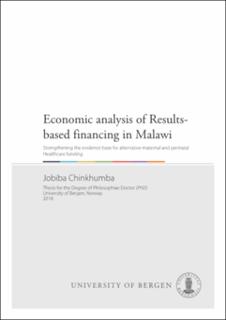| dc.description.abstract | The identification of policies and strategies that can increase coverage of pregnant women and the new-born with priority health interventions, especially for the poor, is one of the key challenges for global health. In the sub-Saharan Africa region, encouraging prospective mothers to deliver their babies in health facilities is one way of increasing coverage of skilled care at the time of delivery. In 2013, the Ministry of Health in Malawi embarked on an innovative initiative called Results-based financing for maternal and neonatal health (RBF4MNH) which provides conditional financial incentives to health workers to increase quality delivery care and to mothers for delivering in health facilities. Yet in the sub-Saharan region, the benefits of facility compared to home-based births; the impact of RBF initiatives on obstetric emergency care seeking and associated costs, and the evidence for RBF efficiencies are lacking. In this thesis, I conducted three separate studies. First, I examined maternal and perinatal benefits of facility-based births relative to home births. I conducted a literature review of population-based cohort studies reporting on maternal and perinatal outcomes by place of delivery in sub-Saharan Africa. The studies were assessed for quality using the Newcastle-Ottawa scale. I used meta-analytic procedures to summarise and describe the risks of maternal and perinatal deaths by place of delivery in the region. I identified nine (9) population-based cohort studies: 6 reporting on perinatal and 3 on maternal mortality. The mean quality score for the studies was high, averaging 10 out of 15 points. A total of 36,772 pregnancy episodes were included in the analyses. Relative to facility births, perinatal mortality was higher among home births, but the difference was only significant when produced with a fixed effects model (OR 1.21, 95% CI: 1.02- 1.46) and not when produced by a random effects model (OR 1.21, 95% CI: 0.79-1.84). At best, 14 perinatal deaths might be averted per 1000 births if women delivered at facilities instead of homes. There was increased risk of maternal mortality for facility-based relative to home deliveries (OR 2.29, 95% CI: 1.58-3.31). Second, using a pre-and post-design with independent controls, I used generalised linear models to ascertain the impact receipt of RBF4MNH had on time to seek care for women experiencing pregnancy related complications and associated household costs. I used primary household survey data conducted in four districts in Malawi: at baseline in 2013 and repeated in 2014 (midline) and 2015 (endline), involving a total of 2, 219 women experiencing complications in their most recent pregnancy before the surveys. Receipt of RBF4MNH was associated with reduced expected mean time to presentation for facility care for women experiencing complications. The reduction in mean time till service was progressive: Relative to non- RBF4MNH areas, time to seek care in RBF4MNH areas decreased by 27.3% (95% CI: 28.4-25.9) at midline and 34.2% (95% CI: 37.8-30.4) at endline. Women with high education attainments, with more severe disease and high parity were more likely to present for care promptly. There was no demonstrable effect of RBF4MNH on overall (direct + indirect) household costs. However, women who received cash transfers as part of RBF4MNH had lower household costs, suggesting that receipt of cash may substitute informal carer’s time sufficiently to lower productivity losses/indirect costs and, ultimately, overall household costs. Thirdly, I used a decision tree model, populated with both primary service use and cost data from Malawi and complimented with secondary epidemiologic data from the international literature, to estimate expected RBF4MNH efficiency in terms of cost per deaths averted and life years gained. Relative to the status quo, RBF4MNH cost USD 42.83 per additional birth, averted 0.0015 death and gained 0.0410 life year. Thus, RBF4MNH had an incremental cost-effectiveness ratio per death averted and life year gained of USD 29,135 and USD 1,045, respectively. At a willingness to pay of USD 1,446 (3 times Malawi Gloss Domestic Product per capita), RBF4MNH had 60% probability of being cost-effective. The cost-effectiveness results were sensitive to assumptions about coverage of facility-based births in RBF supported facilities and share of women accessing quality care in control facilities. I conclude that policies that promote facility-based births can increase perinatal survival, but their benefits on maternal health would be contingent on concomitant quality improvement efforts given high risk of maternal deaths associated with facility deliveries in the SSA region. RBF encourages women with pregnancy related complication to present for facility care early which may lead to better outcomes if quality care is provided. RBF appears borderline cost-effective at high levels of willingness to pay and unlikely to be cost-effective at less than 3 times GDP per capita. Countries should carefully consider overall RBF merits, at health system level, before introducing it as one of the strategies for increasing coverage of facility quality care to reduce maternal and perinatal mortality. | en_US |
| dc.relation.haspart | Paper II: Household costs and time to seek care for pregnancy related complications: The role of results-based financing. Jobiba Chinkhumba, Manuela De Allegri, Jacob Mazalale, Stephan Brenner, Don Mathanga, Adamson S. Muula, Bjarne Robberstad. PLoS ONE 12(9) September 21, 2017. The article is available at: <a href="http://hdl.handle.net/1956/17490" target="blank"> http://hdl.handle.net/1956/17490</a> | en_US |
| dc.relation.haspart | Paper III: Cost-effectiveness of Results-based financing in reducing maternal and perinatal mortality: Evidence from decision tree modeling. Jobiba Chinkhumba, Manuela De Allegri, Stephan Brenner, Jacob Mazalale, Don Mathanga, Adamson Muula, Bjarne Robberstad. The article is not available in BORA. | en_US |
